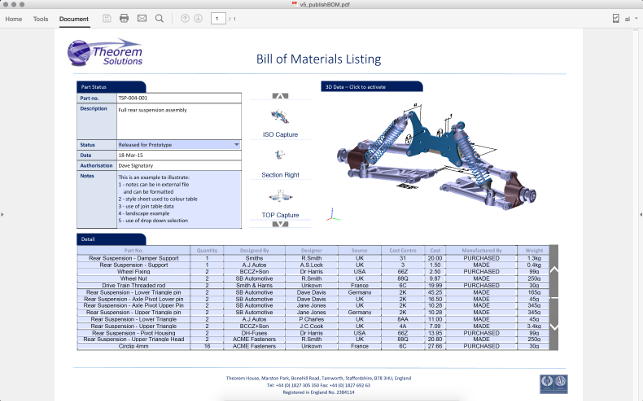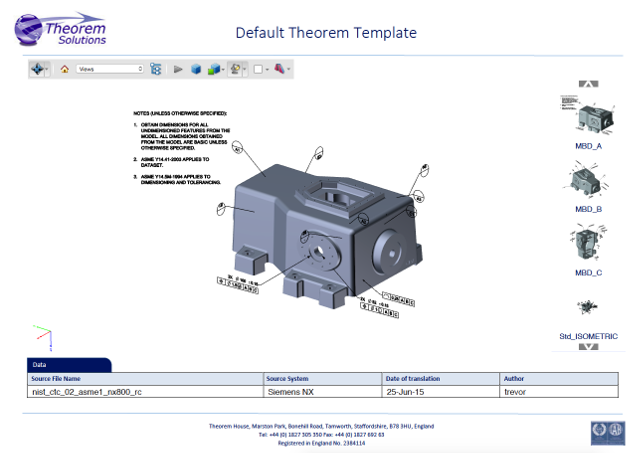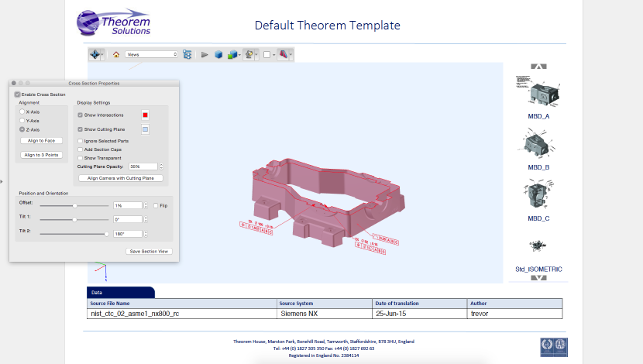When it comes to readily accessible data formats, they don’t get much more universal than PDF. Al Dean takes a look at a new solution from Theorem Solutions that makes PDFs more usable for communicating 3D information
The PDF format is perhaps one of the most widely used formats for communicating a wide range of data. For text, images and tables, it’s pretty much the gold standard.

A bill of materials created using Publish 3D, featuring fully interactive 3D views
In engineering and design circles, this is even more the case. For material safety data sheets, requirements lists or technical drawings, the PDF has become the lingua franca for many. Why?
The reason is that a PDF document can be read by almost anyone. Adobe’s format has the ability to represent information exactly how you want it to appear, with all of the controls you could need to exert, from simple password protection to full-scale digital rights management.
Viewers are plenty and an entire industry revolves around selling add-on tools that complement and build on the capabilities in Adobe’s own suite of software.
But while we’re all used to sharing office and technical documents using PDF, one of its hidden capabilities is the ability to hold 3D data.
We’re not just talking about the ability to show a 3D model embedded in a document, allowing the viewer to spin and pan and zoom, but rather, something much more sophisticated.
A good five or six years ago, Adobe started to make a great deal of noise about how it was enabling its PDF format to support 3D geometry and allow software developers to do interesting things with it.
The company made several acquisitions to support the move, most notably that of Trade and Technologies France (TTF) in 2006. TTF was a data translation specialist that had both a line of converters and translation tools and also its own PRC format, which allowed users to store both precise surface (B-rep) and tessellated geometry in a single file.
Then Adobe decided to focus its efforts elsewhere and closed down the initiative.
This left it with something of an issue: PDF was now 3D-enabled, but the company had no interest in developing the tools to support it or providing software developers with the toolkits they’d need to build those tools themselves.
This is where Tech Soft 3D enters the frame. If you’re not familiar with the company, I wouldn’t be surprised – but I can almost guarantee that you’re using a 3D CAD system with at least one or more of its component technologies inside.
The company provides a range of 3D development toolkits to all of the vendors to assist with their development efforts.
The end result is that PDF is now a well-developed and almost universally accepted 3D data comminication format – and this last part is key. 3D PDF isn’t a translation format, like IGES or STEP.
Instead, it has become a near-universal format that can hold rich 3D geometry, 2D and 3D annotation and all manner of other information.
So how does one take advantage of this?
The answer is that you need an additional tool. Many of the workhorse CAD systems we use on a daily basis have 3D PDF support in their output options, but the output is typically rudimentary – it’s a spinnable 3D model.
The reality is that if you want to take advantage of 3D PDF as a means of communicating engineering and manufacturing information, then you need something else. And that’s where Theorem Solutions’ recently released Publish 3D comes into play.
Introducing Theorem Solutions
If you don’t know Theorem Solutions, it’s a 3D data translation specialist, based in Tamworth, Staffordshire.
It has been developing its line of advanced translation tools for a good two decades now and its reputation is pretty much as good as it gets among some of the leading engineering and manufacturing OEMs in the world.
Alongside its data translation tools for CAD-to-CAD conversion, Theorem Solutions has also been active in the CAD-to-visualisation industry for some time, developing a line of tools for moving data from your 3D design system to formats such as JT, 3DXML or CreoView (ProductView), while ensuring that the required metadata remains intact and in place.
At the same time, it’s also been working on a set of tools to allow engineering and manufacturing customers to take advantage of 3D PDF in a way that goes beyond a pure technology demo and provides something much more realistic in terms of process integration.
This line of tools is called Publish 3D. There are three key products in the Publish 3D suite, so we’ll start with the entry-level product, then look at how you move up the chain.
Theorem Solutions – Publish 3D interactive
This is the starting point of the Publish 3D product line. Essentially, it sits inside your 3D CAD system (assuming you’re running Catia V5, Siemens PLM NX or PTC Creo) and allows you to take your 3D data and prepare interactive 3D PDFs.

One of the NIST-standardised 3D annotation examples, showing how 3D annotation can be displayed in a 3D-enabled PDF
The goal here is to add value to the process and much of this revolves around not just outputting a 3D model that can be viewed, but also taking 3D annotation and using this as the driving reason to use 3D PDF in the first place.
To use it, you find the menu, select the template you want and generate your 3D PDF. It’s really as simple as that.
Theorem Solutions – Templates are key
These templates are fundamental for making good use of this system.
They drive how the information from your CAD system is presented, how the system extracts additional information from the CAD model (such as metadata for part tables and so on), as well as how you configure any 3D annotation views.
As you’ll see from the samples shown alongside this review, these templates are pretty flexible and can feature as much information, or as little, as needed in order to create documents such as requests for quotation, parts lists, data exchange packages and engineering change requests.

3D PDFs include all manner of tools, including dynamic sectioning, as standard
Templates can be created in-house, by copy and pasting elements using Acrobat.
All manner of information can be extracted from the 3D CAD data, whether that’s translation data, CAD attributes, parts lists, author information and so on, to match your own business processes and requirements. Theorem also offers its own customisation service.
So that’s how you use the Interactive version directly from your 3D CAD system — but what if you want to automate the process, or mix in more extended information, perhaps drawn from other business systems and sources?
This is where you need to use the next levels up in the Publish 3D product line.
Publish 3D on demand
Publish 3D On Demand transfers your design from your CAD system and into Theorem’s own software.
This gives you a more flexible approach: opening the design outside of the CAD environment gives it a little more independence.
Publish 3D On Demand includes batch processing of your data from a number of sources in terms of CAD data formats and allows you to publish that data to multiple templates in a single job.
It also opens up the capability of the system to work with JT data alongside the existing NX, Catia V5 and Creo formats.
Another point worth considering is that it’s also possible to extract data from other business systems and include that in your documents — whether that’s information from ERP or MRP systems or from your PLM system.
Publish 3D automated
While both Publish 3D Interactive and On Demand focus on the creation of documents from single sets of data, Publish 3D Automated is a server-based, full-scale enterprise version that gives you support for high volumes of data creation and tight integration with enterprise systems.
It might be linked, for example, to your PLM system and be able to take to advantage of processes kicked off by a much wider range of users of that system.
Conclusion
3D PDF has always had massive, albeit unfulfilled, potential in the design and engineering space. After all, it’s the perfect format for making complex data available to a much larger proportion of the folks who might need it.
There’s no specialised client to download, so IT doesn’t need to spend a month approving desktop software. Almost everyone has got Acrobat Reader, as a bare minimum, on their system already.
The issue instead has always been a lack of awareness of what’s possible with PDFs and a lack of access to tools that allow you to make the most of the format in a process or business workflow.
It’s also the case that the greatest benefits are gained when an organisation has additional information to place into these documents: 3D annotation, PMI, call it what you will, can transform 3D geometry into something instantly more understandable to more people.
Now that more organisations are using this approach, the stage is set for the PDF format to take its rightful place and fulfil its true potential.
Many organisations are looking for more efficient ways to communicate vital engineering and manufacturing information, but more often than not, the traditional methods they use (such as drawings) can’t take advantage of a wealth of 3D data.
Theorem Solution’s new offering, by contrast, allows you to combine designs and data to great effect.
| Product | Publish 3D |
|---|---|
| Company name | Theorem Solutions |
| Price | on application |







